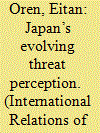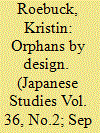| Srl | Item |
| 1 |
ID:
174857


|
|
|
|
|
| Summary/Abstract |
Scholars have recently commented on Japan’s increasing threat perception, either in the context of an ‘increasingly complex security environment’, or in the context of its use by Japanese elites to advance their political goals. Yet, while references to Japan’s threat perception are ubiquitous, conceptual clarity and comprehensive empirical evidence are far less so. This article seeks to address these gaps by conducting a longitudinal study of threat perception in postwar Japan. Data are driven from content analysis of debates in Japan’s national parliament over a period of seven decades (1946–2017). The evolution of Japan’s threat perception is analyzed, and a revisionist account of Japan’s threat perception is put forward. Thus, this study serves both as a metric of threat perception in postwar Japan and as a model for the study of threat perception in international relations.
|
|
|
|
|
|
|
|
|
|
|
|
|
|
|
|
| 2 |
ID:
149260


|
|
|
|
|
| Summary/Abstract |
At the end of the Allied occupation in 1952, the Japanese press reported that two hundred thousand ‘mixed-blood’ children had been fathered and abandoned by foreign (mostly American) soldiers in Japan. Japanese commentators often converged on a single solution: the expulsion of all foreign troops and all ‘mixed’ children from Japan. Although most scholars treat the 1950s sense of ‘crisis’ surrounding ‘mixed’ children as a product of concern for their welfare, the ‘crisis’ is better understood as a complexly co-authored moral panic. Opposition politicians deployed wrath and fear over ‘blood mixing’ to discredit the dominant Liberal Party and its alliance with the United States. Meanwhile, ideological activists and mass media circulated false facts to present ‘mixed’ families as doomed and dangerous. Moral panic over ‘mixed-blood children’ fostered a ‘pure-blood’ identity in Japan after World War II and helped reconstruct Japanese nationalism on a new basis: that of the ‘pure’ race rather than the failed state.
|
|
|
|
|
|
|
|
|
|
|
|
|
|
|
|
| 3 |
ID:
142985


|
|
|
|
|
| Summary/Abstract |
This paper critically reviews postwar population development in Japan and aims to identify unsolved issues, which are possibly shared by other countries, and extract lessons for the future. First, I examine long-term development on fertility and life expectancy in Japan with a brief introduction of pre-war population history. I stress that some critical issues have often been ignored in policy debates and some important new challenges are now emerging, factors that are indispensable to extract lessons for the future. Second, I turn to the official population projections and related issues which again require scrutiny. Third, I emphasize that serious scientific investigation from multiple disciplines is essential to cope with the challenges of demographic changes and that Japan should take the leading role in research for the next generations all over the world.
|
|
|
|
|
|
|
|
|
|
|
|
|
|
|
|